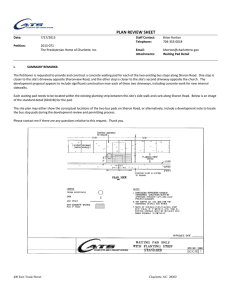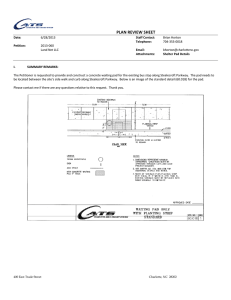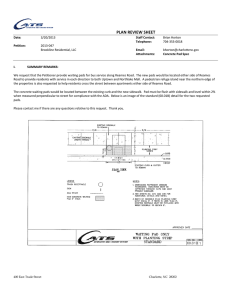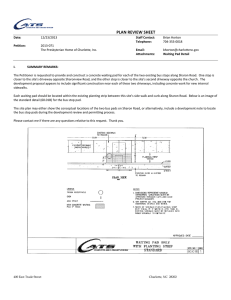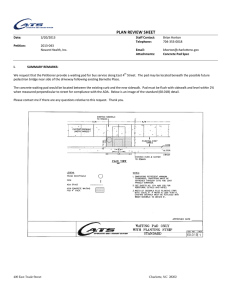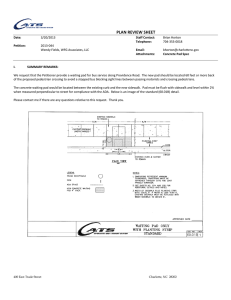A DISTRIBUTED SHARED KEY GENERATION R. S.
advertisement
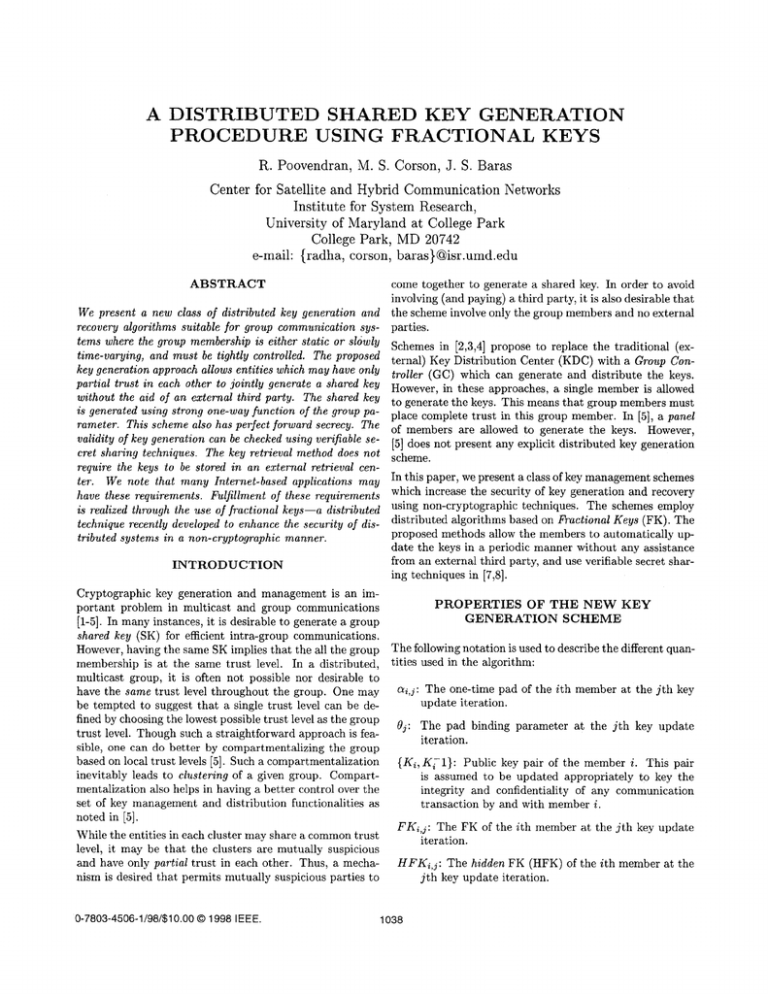
A DISTRIBUTED SHARED KEY GENERATION
PROCEDURE USING FRACTIONAL KEYS
R. Poovendran, M. S. Corson, J. S. Baras
Center for Satellite and Hybrid Communication Networks
Institute for System Research,
University of Maryland at College Park
College Park, MD 20742
e-mail: { radha, corson, baras}@isr.umd.edu
ABSTRACT
come together t o generate a shared key. In order t o avoid
involving (and paying) a third party, it is also desirable that
W e present a new class of distributed key generation and the scheme involve only the group members and no external
recovery algorithms suitable f o r group communication sys- parties.
t e m s where the group membership is either static or slowly Schemes in [2,3,4] propose to replace the traditional (extime-varying, and m u s t be tightly controlled. T h e proposed ternal) Key Distribution Center (KDC) with a Group Conkey generation approach allows entities which m a y have only troller ( G C ) which can generate and distribute the keys.
partial trust in each other t o jointly generate a shared key However, in these approaches, a single member is allowed
without the aid of a n external third party. The shared key t o generate the keys. This means that group members must
is generated using strong one-way function of the group pa- place complete trust in this group member. In [5], a panel
rameter. This scheme also has perfect forward secrecy. T h e of members are allowed t o generate the keys. However,
validity of key generation can be checked using verifiable se- [5] does not present any explicit distributed key generation
cret sharing techniques. T h e key retrieval method does not scheme.
require the keys t o be stored in a n external retrieval center. W e note that m a n y Internet-based applications m a y In this paper, we present a class of key management schemes
have these requirements. Fulfillment of these requirements which increase the security of key generation and recovery
is realized through the use of fractional keys-a distributed using non-cryptographic techniques. The schemes employ
technique recently developed t o enhance the security of dis- distributed algorithms based on Fractional K e y s (FK). The
proposed methods allow the members t o automatically uptributed systems in a non-cryptographic manner.
date the keys in a periodic manner without any assistance
from an external third party, and use verifiable secret sharINTRODUCTION
ing techniques in [7,8].
Cryptographic key generation and management is an imPROPERTIES OF THE NEW KEY
portant problem in multicast and group communications
GENERATION SCHEME
[l-51. In many instances, it is desirable t o generate a group
shared key (SK) for efficient intra-group communications.
However, having the same SK implies that the all the group The following notation is used to describe the different quanmembership is at the same trust level. In a distributed, tities used in the algorithm:
multicast group, it is often not possible nor desirable t o
ai,j: The one-time pad of the ith member at the j t h key
have the same trust level throughout the group. One may
update iteration.
be tempted t o suggest that a single trust level can be defined by choosing the lowest possible trust level as the group
B j : The pad binding parameter at the j t h key update
trust level. Though such a straightforward approach is feaiteration.
sible, one can do better by compartmentalizing the group
based on local trust levels [5]. Such a compartmentalization { K i ,K i l } : Public key pair of the member i. This pair
inevitably leads t o clustering of a given group. Compartis assumed t o be updated appropriately to key the
mentalization also helps in having a better control over the
integrity and confidentiality of any communication
set of key management and distribution functionalities as
transaction by and with member i .
noted in [5].
FKi,j: The FK of the ith member at the j t h key update
While the entities in each cluster may share a common trust
iteration.
level, it may be that the clusters are mutually suspicious
and have only partial trust in each other. Thus, a mecha- HFKi,j: The hidden FK (HFK) of the ith member at the
nism is desired that permits mutually suspicious parties t o
j t h key update iteration.
0-7803-4506-1/98/$10.00 0 1998 IEEE.
1038
S K j : The group SK at the j t h key update instance.
However, to ensure the integrity of the scheme, this recovery should be possible only if all the remaining contributing
A -+ B : X:Principal A sends principal B a message X. members cooperate. This feature deviates significantly from
the existing key generating schemes [2,3,4]. We note that
Our message format is {{Ti,
M , j , M s g } K S 1 } K R ,where
the requirement that an individual member acting alone not
be able t o obtain the FKs of other contributing members is
0 Ti: a real-valued, wallclock time stamp nonce
similar t o protecting individual private keys in the public
generated by member i.
key
crypto systems.
0 M : denotes the mode of operation with “I” for
Initialization mode, “6”for key Generation mode,
DESCRIPTION OF THE MULTIPARTY KEY
and “R” for key Recovery mode.
0
0
0
0
j: integer-valued, denotes the current iteration
number.
Msg: the message t o be sent.
K;’: Denotes the private key of the sender S.
KR: Public key of the receiver.
GENERATION SCHEME
The followihg is a list of assumptions regarding the algorithm, some of which may appear rather abstract at first
glance:
0
In developing the new key scheme, we note that the following properties are desirable for a multiparty key generation
scheme:
0
0
A single participating member, without valid permissions, should not be able t o obtain the FK of another
member.
0
If a FK-generating member has physically failed, compromised or removed, the remaining FK-generating
members should be able t o jointly recover the FK of
the failed member (this requires not majority voting
but total participation).
We note that the first property simply states that the distributed key generation scheme has t o be such that each
FK space has at least the same size as the final SK space.
Hence, each member may generate FK of different size but,
when combined, they lead to a fixed length SK.
It is computationally difficult t o perform crypto analysis on a cryptographically-secure random key by search
methods if the key length is sufficiently large.
A FK contributed by a participating member should
have the same level of security as the group SK.
0
There exist two commutative operators 0and 0 which
form an Abelian group when operating on the key elements.
0
0
0
0
The keys are all L bits in length, and all members
know this length.
The number of participants in generating the SK is
fixed as n (where n may be a function of 0 and 0).
There is a mechanism for certifying the members participating in the key generation procedure, for securely exchanging the quantities required in the algorithm and for authenticating the source of these
quantities.
Every member has the capability t o generate a
cryptographically-secure random number, or a fresh
quantity, of length at least L bits.
The second property has to do with the need for protection With the assumptions above, we note that the key manageof individual FKs that is desired due to the absence of a ment scheme consists of three major parts:
centralized key generation scheme. In the current scheme,
1. Initialization-consisting of member selection, and seevery member perform an operation t o hide its FK such
cure initial pad and binding parameter generation and
that, when all the hidden FKs (HFK) and the group padistribution;
rameter are combined, the net result is a new SK. We note
that even if a HFK is known, the problem of obtaining the
2. Key Generation-an iterative process consisting of
actual FK or the SK needs further computation. We will
fractional, hidden and shared-key generation; and
describe the requirements of the FK concealment mechanism in the next section.
3. Key Recovery-required only in the case of a member
node failure or compromise.
If a contributing member physically fails, becomes compromised, or has t o leave the multicast group, then it becomes
INITIALIZATION ALGORITHM
necessary t o replace the existing member with a new member. Hence, the newly-elected member should be able t o
securely recover the FK generated by the replaced member.
1039
2. The following steps are repeated for i = 2, . . . ,n - 1:
A Group Initiator (GI) first selects a set of n FK-generating
members, and the GI may be one of these members (how it
occurs is not specified and is application-dependent). The
GI then either (1) contacts a Security Manager (SM)-a
third party who is not a FK-generating member-who generates the initial pads and the binding parameter and distributes them to the members, or (2) initiates a distributed
procedure among the group members t o create these quantities without the aid of a third party.
(a) Member i generates a uniform random variable
vi,l of bit length L.
(b) Member i then operates on the quantity it received from member i - 1 as 6i-1 8vi,l = &.
+
3. Eventually, the group member i = n receives 6,-1
and then generates a uniformly-distributed random
quantity vn,l of bit length L , performs 6,-1 8 v,,1 =
6,, and then securely sends it to the initiating member
i = 1 as n + 1: {{Tn,l,l,Sn}K,~}~l.
SECURITY MANAGER-BASED
INITIALIZATION
The initial pads and binding parameter are distributed to
each member i, for i = 1,.. . , n , as
4. The initiator (member 1) then decrypts it and performs y 8 6, = 91, and then sends & to each member
S M +i : {{TSM,I,1,ai,l,el}K,~}Ki
where ai,l-its initial one-time pad-is
al,l 8 a2,18 . . . 8 a,,1 = el.
+
(c) Member i then sends the result to member i 1
as i + i 1: {{Ti,I,1,C ~ ~ } ~ ~ I } K ; + ~ .
i , f o r i = 2 , ...n , a s
1 +i : { { z , I , l , e l } K ; l } K i .
computed such that
5. Each member i privately computes ai,^ = 91 8 vi,^,
and uses ai,l as its initial pad.
DISTRIBUTED INITIALIZATION
We note that these two approaches of initialization-security
manager-controlled and distributed-are not equivalent unless additional security assumptions are made. For example,
in the case of distributed initialization within the group, we
point out that using following attack is feasible.
n
\
I
Assume that members i - 1 and i + 1 conspire to obtain
the secret of member i , where the numerical ordering corresponds to the order of message passing in the distributed
algorithm.
Member i - 1 sends Si-1 to member i as per the algorithm, and also to member i + l without i’s knowledge.
I
I
/
Member i, who is unaware of the conspiracy between
i - 1 and i + 1, computes 6i = 6 i - 1 8 vi,l and sends it
to member i + 1 securely.
/
+
Member i 1 can now compute
obtain the secret vi,l of member i.
= didl 8 Si and
However, the secret vi,^ generated by member i becomes
part of the pads (i.e. the a’s) of members i - 1 and i 1.
Hence, the knowledge of vi,l reduces the entropy of the
The GI (assumed to be a member and denoted here by the initial pads of the conspiring members. Thus, while the
index 1 shown in Figure 1) can perform the following steps attack is feasible, there may not be any incentive to conspire
(1)-(5) t o generate the initial parameters of the group:
in this manner.
+
Figure 1. Distributed initialization algorithm
KEY GENERATION ALGORITHM
1. Generate two uniformly-distributed random quantities y and v1,1 of bit length L , operate on these two The key generation algorithm is an iterative process dequantities as ~ @ ) Y =
~ J
dl, and send the result to mem- picted in Figure 2. Each iteration j requires as input (inber 2 (the “next” member in the group) as 1 --+2: dicated as step (0) in the figure) a set of one-time pads
ai,j, i = 1,...,n, and the binding parameter O j , which
{{Tl,I,l,WK;1}Kz.
1040
! $
P
I
............
-L
amount of computational burden in obtaining the FK
as a crypto analyst; i.e. trust is not unconditional.
WE note that the burden of breaking all the (n-1)
terms simultaneously leads t o a (n-l)L dimensional
search although the key is in L dimensional space.
. .....-............:.....
.(
I..
iteration 4
j -
Even if an outsider captures and decrypts a packet
and obtains the HFK of a single participating member, (a) having a HFK does not give any advantage
to the crypto analyst in decrypting any message encrypted with the SK, (b) attacker has to find the
corresponding remaining time varying n - 1 HFKs.
Such is the case since the keys are transported in a secure manner. Hence, only the participating members
have the direct access-maybe after decrypting-to
the HFKs. For an outsider, it may be much harder
to simultaneously attack and obtain these n - 1 parts
since the search space will be (n- l)L dimensional.
Figure 2. Iteration and mappings of the key generation
algorithm
are obtained from the initialization algorithm for iteration
> 1.
j = 1, and from the preceding iterations for j
The iterative key generation algorithm consists of the following steps (1)-(5):
1. For i = 1 , . . . ,n, a member i generates a
cryptographically-secure random number FKi,j.
RETRIEVAL OF THE FRACTIONAL KEY AND
PAD OF A FAILED NODE
2. For i = 1,.. . ,n, a member i generates a quantity
HFKi,j = ai,j 0 FKi,j, and all the members securely
exchange the HFKs as
The following steps are involved in recovery of the FKQ
and a;,j of the node failed I , where j represents the iteration
V 1 5 1,m 5 n,l # m,
number in which the node was compromised or failed.
1 +m: { { ~ , G , ~ , H F K ~ , ~ } K ; ~ } K , .
3. Once the exchange is complete, each member com-
Any one FK-generating member-called the Recovery Initiator (RI)-must initiate recovery and give the
HFK of the failed node i to the newly-elected node i
as RI + i : { { T R I , R , ~ , H F K ~ , ~ } K ; ; : } K ; .
putes the new group parameter 6 j + l as
e j + l = O j O HFKl,j O HFK2,j O *
8 HFKn,j.
=+O j + l = FKl,j 8 FK2,j 8 * * * FKn,j.
e
*
4. If the resulting group parameter O j + l is cryptographically2. The RI must also give the newly-elected node i the
insecure for a particular application, all members can
R,~,SK~),;--}K~.
current SK as R I 3i : {{TRI,
repeat steps (1) - (3) creating a new high quality group
parameter O j + l .
Using the same algorithm as is used for distributed
initialization,
with the following replacements: (a) 6
= Oj+lO
5. For i = 1,.. . ,n, a member i computes a i , j + ~
by and (b) al,j by &. Except for the changes in
FKi,j, and SKj = f ( e j + l ) where f(.) is a strong onethe notation and the number of members participatway function.
ing, the algorithm for pad generation is same as for
distributed initialization. Hence, at the end of this
The steps (1)- ( 5 ) present the computational steps for gendistributed
pad generation, each member 1 has &,j as
erating the keys at each update. At the end of step ( 5 ) ,
its
pad
for
key recovery process, and all these pads
we have the SK for the current iteration. Note that the
are
bound
with
the parameter t.
quantity ai,j+l is computed such that, for an outsider, obtaining ai,j+l is much harder even if the actual key SKj
For 1 = 1 , . . .,n - 1, each node 1 then computes a
is compromised at any key update time interval ( j , j 1).
modified hidden fractional key HFK1,j = ,@,jOFKl,j
Knowing the group key does not reveal the group parameand hands it =he
newly-elected member i as 1 +
ters and hence the tight binding of the members will not be
i
:
{
{
~
,
R
,
j
,
H
F
K
l
,
j},;l}K;.
broken by the loss of the shared key!. We note the following
additional features of the key scheme:
Node i then combines all of the modified HFKs and
<
+
0
-
recovers the fractional key FK;,j using the operation
FK;,j = OHFK1.j O . . . 8HFKn-l,j O O j + l .
<
Although all the members have each HFKi,j, obtaining the FKi,j or a i , j + l involves search in the Ldimensional space. Hence, even if a fellow member
becomes an attacker, that rogue member has the same
Node i then extracts the pad
ai,j = HFK;,j 0 FK;,j.
1041
ai,j
using the operation
We note that the recovered values of FKi,j and a;,j are
unique. Once the new node recovers the fractional key of
the compromised node, it can inform the other contributing members t o update the iteration number j t o j 1,
and then all members can execute the key generation algorithm. Note that even though the newly-elected member
recovers the compromised fractional key and pad, the next
key generation operation of the new node does not use the
compromised key or pad. Hence, even if the attacker possesses the fractional key or pad at iteration j, it does not
allow the attacker to obtain the future fractional keys or
pads without any computation.
+
VERIFIABLE SECRET SHARING FOR KEY
GENERATION SCHEME
Since there are multiple entities involved in key generation,
it becomes important t o have a mechanism to verify if the
parameters exchanged actually contribute to the generated
shared key. The verification steps have t o be followed at
(1) SM-based group initialization, (b) Distributed Group
initialization, (c) SK-generation iteration and (d) key recovery.
SM- based Initialization
In the case of the SM-based scheme, each member i needs
to
make sure that the SM uses non-trivial values for its ai,l
A SPECIFIC CHOICE OF THE FUNCTIONS 8
and
91. Since each member needs t o protect its individual
AND 0
pad value, one method for openly checking correctness of
the pads is to generate a public value that will enable all the
We have presented a class of multiparty key generation alkey generating members t o check their correctness without
gorithms where a given instance of the class is determined
revealing the actual value of the individual pads. Such a
by choice of functions 8 and 0 . Depending on the choice of
verification technique falls under the category of VSS [7, 81.
these functions, the lower bound on n may be determined.
If one wants t o check if the individual initial pads ai,^ given
We note that among the possible choices for both 8 and
by the security manager are “good”, the scheme given below
0 are the modulo 2 addition (or XOR) function when n is
can be used.
even, and the modulo 3 addition function when n is oddboth of which we denote here with @ simply meaning mod1. Any one member (possibly the SM) picks a very large
ulo addition.
prime number p and sends it t o all the members. The
Clearly, the choice of n = 2 is not appropriate for such a
number picked should larger than the possible range
scheme. Although choosing n = 3 does not instantly exof the SK value. The same member also sends a genpose a secret pad a; when a participating member becomes
erator g of the multiplicative group under p .
an attacker (i.e. a rogue), the following attack-called frac2. Each member i picks a random polynomial fi with
tional attack (FA)-is feasible.
value 0 a t the origin.
Lemma: When 8 is an @ function, independent of how nontrivial the bit-length of the key is, choosing n = 3 permits
a FA.
3. Each member i adds the polynomial value t o the pad
value, generates
= gaijl+f; and sends the result
t o all the other members.
Proof: Assume that the time instant a t which one member
i (i = 1 or 2 or 3) becomes a rogue is j. At this time the
4. Each member i computes go’ = j = n ai,l = g o,+xj:; f,
members have values of a1,j = HFK2,j @ H F K , , j , a 2 , j =
and evaluates it a t origin t o check if the value is equal
H F K s , j @ H F K l , j ,a 3 , j = H F K l , j @ H F K Z , j . Every memto
go’.
ber also has access t o the current 9j+l and their own F K l j
( 1 = 1, 2, 3). At this stage, obtaining the a component
where fail5 . Each member i checks if
of any other member is as computationally intensive as an
ure
(inequality)
means
that
some
or
all
of
the given
outside attacker trying to obtain
However, if a mem81.
pads
don’t
correspond
t
o
the
given
ber, say i = 1, is compromised and releases its secret a l , j ,
then each of the other members can use this and compute
F K l d = c u l , j @ f 9 j . Since the f9j+l = FKl,jcBFK2,j@FK3,j,We note that it is also possible t o use specific polynomial
each member can now compute the other non-rogue mem- based techniques to allow members t o verify if the individual pads are correctly distributed to the members.
ber’s FK as well.
nj=,
h
6,
This leads t o the following Corollary: When 0 is an @
function, independent of how non-trivial the bit-length of Distributed Initialization
the key, the minimum number of members t o prevent a FA
In the case of distributed initialization, the following scheme
by a single rogue member for the multiparty key scheme is
can be used t o check if the GI gives the 9 that is generated
4.
from the contributions of the group members.
1042
1. Any one member (possibly the GI) picks a very large shared key at a particular time interval compromises neiprime number p and sends it to all the members. ther the integrity of the future keys nor the integrity of the
The number picked should be larger than the pos- past keys.
sible range of the SK value. The same member also
sends a generator g of the multiplicative group under
REFERENCES
P.
2. The GI computes g~ and g v l , ~, and makes it available [l]R. Canetti, B. Pinkas, “A taxonomy of multicast security
issues” , INTERNET-DRAFT, May 1998.
t o all the group members.
3. Each member i publishes gvi.l making it available only [2] H. Harney, C. Muckenhirn, “GKMP Architecture”, RFC
2093, July 1997.
t o the group members.
4. Each member i checks if gel & n ~ y l g v j 2 1where
,
failure (inequality) means that the pad binding parameter and the individual pads do not agree. In this case,
since every member publishes its g v j . ,~ it is possible
to find exactly which member’s pad does not agree
without knowing the actual value of the pad.
We note that similar testing can be done for the 9 generation
stage. We omit that due t o space limitation.
CONCLUSIONS AND FUTURE WORK
We presented a distributed key generation scheme that allows a pre-specified number of members t o jointly generate
and update a shared key. We showed that it is possible t o
make use of the distributed nature of the group-through
the use of non-cryptographic techniques-to securely generate and distribute (in the sense of computational security) the future keys. This is achieved by parameterizing
the distributed group with a time-varying quantity that is
computed at each key update. The parameter binds the
members’ dynamic one-time pads such that, without knowledge of this parameter, it is not possible t o generate a valid
one-time pad and, hence, a valid fractional key. In other
words, the members’ fractional keys are mixed or hidden
with these time-varying pads that implicitly depend on the
time-varying group parameter. Hence, even if the hidden
fractional keys are obtained by an attacker, in the absence
of the time-varying group parameter, the attacker does not
have immediate access t o the group key. Thus, this approach increases group security in a non-cryptographical
manner.
[3] H. Harney, C. Muckenhirn, “GKMP Specification”, RFC
2094, July 1997.
[4] A. Ballardie, “Scalable Multicast Key Distribution”, RFC
1949,
lgg6-
[5] R. Poovendran, S. Ahmed, S. Corson, J . Baras, “A Scalable Extension of Group Key Management P r o t o ~ o l ’Proc.
~,
of znd Annual ATIRP Conference, 187 -191, Feb. 2-6, 1998,
Maryland.
161 M. Bellare and S. Micali, “Non-Interactive Oblivious
Transfer and Applications” , Advances in Cryptology - Crypto
’89, Springer-Verlag, 547-557.
[7] P. Feldman, “A Practical Scheme for Non-Interactive
Verifiable Secret Sharing”, Proc. of IEEE Fund. Comp.
Sei., 427-437, 1987.
[8] T. P. Pedersen, “Non-Interactive and Information-Theoretic
Secure Verifiable Secret Sharing” , Advances in Cryptology CRYPTO, LNCS 576:129-140, 1991.
[9] G. J . Simmons, LLAn
Introduction to Shared Secret and/or
Shared Control Schemes and Their Applications”, G. J .
Simmons, editor, Contemporary Cryptology: The Science
of Information Integrity, 441-497, IEEE Press, 1992.
We also showed how the group can be initialized with or
without an external entity, and still recover the fractional
keys of a failed node without an external entity. In developing our methods, we were able t o provide some VSS features
t o verify that the group parameter, and the member generated secrets, are indeed related.
More importantly, the group shared keys are generated using a strong one-way function and hence the loss of the
1043


